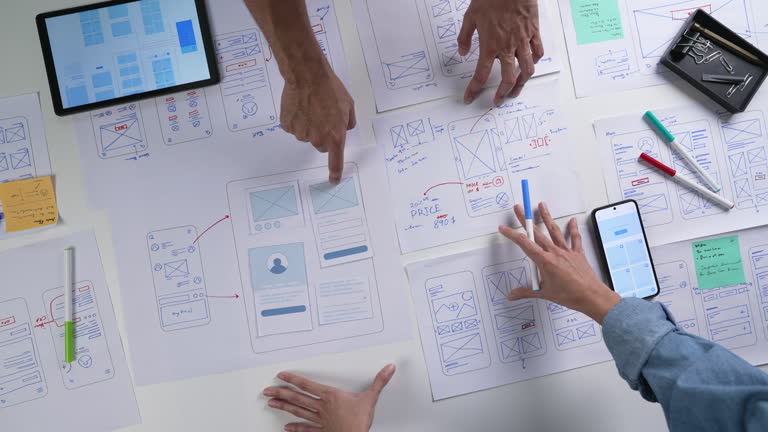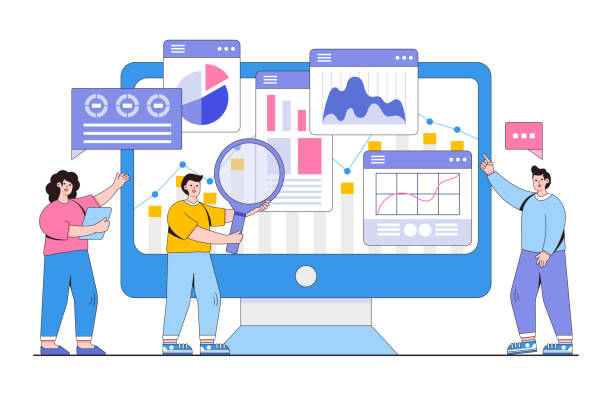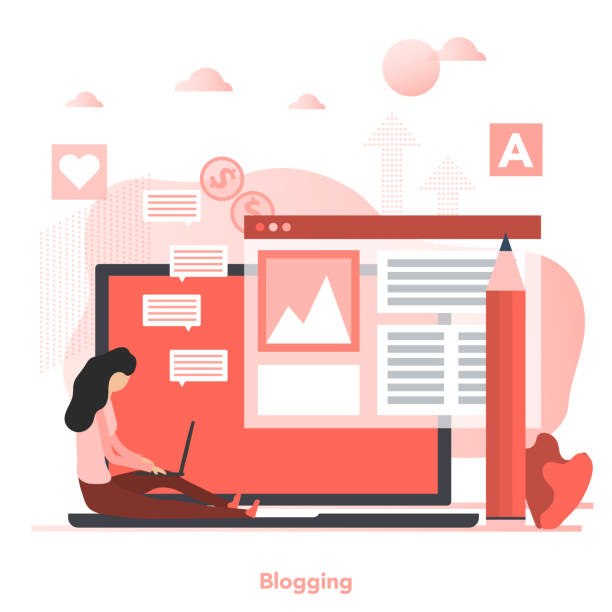Why Website Speed Matters? An Introduction to Fast Website Design

In today’s world where speed is paramount, the importance of fast website design has become more evident than ever.
Internet users have little patience and expect websites to load in a fraction of a second.
If your site is slow, visitors will quickly leave it and go to your competitors.
This not only leads to a decrease in website traffic but also seriously damages your #SEO_ranking.
A slow site provides a poor #UX (user experience) and, as a result, the #conversion_rate also sharply drops.
Imagine you are shopping online and each page takes a long time to load; you will surely get tired and abandon the purchase halfway.
Therefore, website loading speed is a critical factor for online success.
This section explains the main reasons for the importance of website speed and the negative consequences of its slowness, forming the basis for the discussion on fast website design.
Tired of losing customers due to poor e-commerce website design? With Rasaweb, solve this problem forever!
✅ Increase sales and visitor-to-customer conversion rates
✅ Smooth and engaging user experience for your customers⚡ Get free consultation
Foundational Principles for Building a High-Speed Website

To achieve fast website design, you must be aware of its foundational principles.
These principles include optimizing server-side code, choosing appropriate hosting, and using caching techniques.
One of the most important factors is image optimization; high-volume images can severely reduce loading speed.
Compressing images without losing quality is one of the first steps.
Also, minimizing CSS and JavaScript codes and removing extra and unnecessary codes play a key role in increasing speed.
Utilizing modern techniques such as Lazy Loading for images and videos also helps to load content only when it is visible to the user.
These approaches not only accelerate loading but also reduce server resource consumption and lead to fast and efficient website design.
Understanding these principles and implementing them correctly will pave your way to building a high-speed website.
The Role of Server, Hosting, and CDN in Fast Website Design

The technical infrastructure of a website is considered the backbone of its speed.
Choosing a powerful server and quality hosting is the first step in fast website design.
Shared hosting with limited resources often leads to site slowdowns, while dedicated servers or VPS with more resources offer higher speeds.
Also, the physical proximity of the server to your audience matters; a server located in the geographical region of your main users will have less response time.
Using a Content Delivery Network (CDN) is another effective solution.
A CDN stores your website’s static content (such as images, CSS, and JavaScript) on various servers worldwide and selects the closest server to deliver content to the user, which significantly increases loading speed.
This specialized approach not only reduces the load on the main server but also improves user experience and is one of the most important factors in fast website design.
Below you can see a comparison table for choosing suitable hosting for speed.
| Hosting Type | Advantages for Speed | Disadvantages for Speed | Suitable for |
|---|---|---|---|
| Shared Hosting | Cheap, easy setup | Limited resources, affected by other sites, potential slowness | Small and new websites with low traffic |
| VPS Hosting | Dedicated resources, more control, better performance than shared | Requires more technical knowledge, more expensive than shared | Medium websites with growing traffic |
| Dedicated Server | Highest performance, full control, ample resources | Very expensive, requires high technical knowledge | Large websites with high traffic and specific needs |
| Cloud Hosting | High scalability, pay-as-you-go, high stability | More complexity, variable cost | Websites with variable traffic and need for high flexibility |
Frontend Optimization for a Fast User Experience

Apart from server infrastructure, optimizing frontend (client-side) code plays a vital role in fast website design.
This section includes optimizing images, compressing CSS and JavaScript files, and using optimized rendering techniques.
GZIP compression for files can significantly reduce their size and speed up loading time.
Also, combining and minifying CSS and JavaScript files reduces the number of requests to the server and increases the initial page load speed.
Ensuring that CSS is loaded at the beginning of the HTML code and JavaScript at the end allows the browser to render the main content of the page faster.
Optimizing fonts and using modern image formats like WebP can also reduce the overall volume of downloaded data.
These actions are practical and important guidelines that directly affect the user’s visual experience and the responsiveness of the website, and the faster the website loads, the better the user experience and the higher the likelihood of the user staying on the site.
Are you tired of your e-commerce website having visitors but no sales? Rasaweb solves your main problem with professional e-commerce website design!
✅ Significant sales increase with targeted design
✅ Flawless user experience for your customers
⚡ Get a free consultation!
Content Strategy for Increasing Website Loading Speed

Content is king, but heavy content can dethrone your speed king! Fast website design is not limited to technical codes; content strategy also plays a role.
Intelligent use of videos, images, and animations without compromising speed is a significant challenge.
For example, instead of directly embedding large videos, you can use external services like YouTube or Vimeo and only display their thumbnail.
Also, for text content, use short paragraphs, bullet points, and clear headings to increase readability and lighten the load.
Using standard web fonts and limiting the number of custom fonts also helps optimize speed.
This educational approach helps you deliver rich and engaging content without sacrificing your site’s speed.
Optimized content not only increases speed but also plays an important role in SEO.
Tools and Methods for Measuring Website Speed

To know how successful your fast website design has been, you need to measure it.
Many tools are available for measuring website speed, each examining specific criteria.
Google PageSpeed Insights, GTmetrix, and Pingdom Tools are among the most popular and powerful of these tools.
These tools not only show your site’s speed score but also provide suggestions for improving performance; from image optimization to JavaScript and CSS code compression.
Also, checking Google’s Core Web Vitals (such as LCP, FID, and CLS), which directly affect SEO ranking, is crucial.
This analytical section helps you identify your site’s weaknesses and improve its performance by making the necessary changes.
Continuous measurement and monitoring of speed is an ongoing process in fast website design that should not be overlooked.
The Impact of Website Speed on SEO and User Experience (UX)

As mentioned earlier, website speed not only affects user experience but is also an important factor in SEO ranking.
Google has officially stated that page loading speed is one of the main criteria in its ranking algorithm.
Slow sites have higher bounce rates, meaning users quickly leave them.
This signals to search engines that your site does not have valuable content or provides a poor user experience.
In contrast, fast website design leads to lower bounce rates, longer user engagement on the site, and ultimately, better ranking in search results.
A smooth and uninterrupted user experience encourages users to return and interact more with the site and directly impacts conversion rates and customer loyalty.
This is important news for any online business seeking sustainable success.
Below is a table of the main Core Web Vitals metrics that Google uses to measure user experience and speed.
| Metric | Full Name | Explanation | Good Threshold |
|---|---|---|---|
| LCP | Largest Contentful Paint | Time to load the largest visual element on the page | < 2.5 seconds |
| FID | First Input Delay | Time between user’s first interaction and browser’s response | < 100 milliseconds |
| CLS | Cumulative Layout Shift | Amount of unexpected layout shift of page elements during loading | < 0.1 |
Common Mistakes and How to Avoid Them in Website Speed Optimization

Many developers and website owners make common mistakes on the path to fast website design that can render their efforts ineffective.
Do you know what kills your site’s speed? One of the biggest mistakes is neglecting image optimization and uploading them with high volumes.
Also, excessive use of unnecessary plugins and add-ons in Content Management Systems (CMS) like WordPress can severely reduce site speed.
Not using caching is another common mistake that leads to reloading the entire page on every visit.
Ignoring website responsiveness (Responsive Design) not only harms the user experience on mobile devices but can also reduce loading speed.
This thought-provoking content helps you identify and avoid these mistakes, and instead focus on proven techniques for fast and efficient website design.
Losing potential customers due to an unprofessional website? Rasaweb is your answer! With our specialized corporate website design services:
✅ Enhance your business’s credibility and standing
✅ Experience attracting more targeted customers
⚡ Act now to get a free consultation!
The Future of Web Design and Fast Website Performance

The world of the web is rapidly evolving, and the future of fast website design will also undergo changes.
New technologies like HTTP/3, WebAssembly, and next-generation image formats (like AVIF) promise incredible speeds.
Mobile-first indexing and the increasing importance of mobile user experience force developers to focus more on optimization for mobile devices.
The advancement of artificial intelligence may also automatically perform speed optimizations in the future.
These exciting news developments indicate the path the web is taking; a path that daily adds to the importance of speed and efficiency.
Developers must keep pace with these changes to continue providing high-performance and fast websites that meet the needs of future users.
Conclusion: Building a Fast and Sustainable Website

Ultimately, fast website design is no longer a luxury option, but an undeniable necessity for survival and success in the digital space.
From choosing appropriate hosting and server-side optimization to compressing frontend files and intelligent use of content, every component of your website affects its final speed.
Remember that speed directly impacts SEO, user experience, and ultimately your business’s success.
By implementing the principles mentioned in this article and using available measurement tools, you can build a website that is not only fast but also has stable performance in the long run.
Investing in fast website design is an investment in the future of your online business.
We hope this comprehensive guide has helped you build a fast and successful website.
This topic is both engaging and very serious for everyone looking to improve their website’s performance.
Frequently Asked Questions
| Question | Answer |
|---|---|
| What is fast website design? | A process for building a website that loads quickly and provides a smooth and optimized user experience. |
| Why is website speed important? | Increases user satisfaction, improves search engine ranking (SEO), reduces bounce rate, and increases conversion rate. |
| What factors affect website speed? | Page size, number of HTTP requests, image optimization, JavaScript and CSS codes, server speed, and use of caching. |
| How can website speed be measured? | Using tools like Google PageSpeed Insights, GTmetrix, Pingdom Tools. |
| How can website speed be increased? | Image optimization, file compression (CSS, JS, HTML), browser caching, reducing redirects, choosing suitable hosting. |
| Does fast website design mean low quality? | No, fast design means designing with a focus on speed and efficiency, not reducing design or content quality. |
| What is the role of hosting in website speed? | The speed and quality of the hosting server directly affect the website’s response time and thus the loading speed. |
| How can images be optimized for speed? | Using appropriate formats (e.g., WebP), compressing images without significant quality loss, specifying exact dimensions for images. |
| Can complex websites also be fast? | Yes, with appropriate architecture, code optimization, and resource management, even complex websites can have high speed. |
| Is fast website design the same as Agile development? | No, fast website design focuses on the end result (a fast website), while Agile development is a methodology for project management and software development. |
And other services of Rasaweb Advertising Agency in the field of advertising
Smart Data Analysis: A new service for improving SEO ranking through attractive UI design.
Smart Reportage: Professional optimization for customer behavior analysis using precise audience targeting.
Smart Custom Software: A professional solution for online growth focusing on marketing automation.
Smart Conversion Rate Optimization: A fast and efficient solution for campaign management focusing on attractive UI design.
Smart Sales Automation: A fast and efficient solution for customer behavior analysis focusing on precise audience targeting.
And over a hundred other services in the field of internet advertising, advertising consulting, and organizational solutions
Internet Advertising | Advertising Strategy | Advertorial
Sources
Optimized Website DesignIncrease Website SpeedWebsite SEO OptimizationFast Website Design Tips
? For the growth and prominence of your business in the online space, Rasaweb Afarin Digital Marketing Agency is by your side, offering the best services. To enhance your digital presence and learn more about our solutions, including our professional services in personal website design, please visit us.
📍 Tehran, Mirdamad Street, next to Central Bank, Kazeroun Jonoubi Alley, Ramin Alley, Plaque 6


